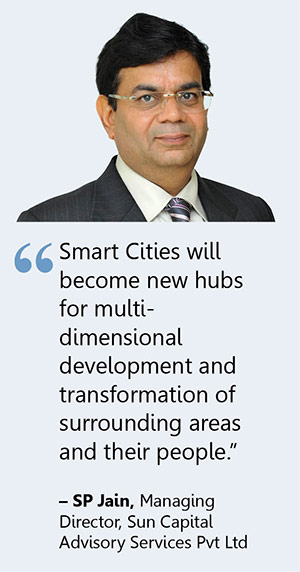Based on a report prepared by investment banking firm Sun Capital Advisory Services
The development of Smart Cities envisioned by the Government of India aims to drive target urban areas’ economic growth thereby enhance people’s living standard. Nearly a quarter of India’s population is likely to be positively impacted, direct and indirectly by the Smart Cities Mission (SCM) projects. The idea is to look at compact areas with focus on sustainable inclusive development on a replicable model which will act like a lighthouse to other aspiring urban local bodies. The impact of developing 100 tech-enabled smart cities over a period will be felt in all three sectors of the local economy viz services, manufacturing and agriculture and develop a positive feedback loop: each activity supporting another and so on; from Smart Cities to Smart Lifestyle to building Smart Nation.
As opposed to manufacturing-led growth 
in the past several decades, that accompanied large increase in migration thereby burdening urban centers’ very ability to offer even minimum services, SCM is majorly modeled on the services-led growth, including education, health, tourism and hospitality that harness local labour with high-tech infra tools and solutions.
In its report titled “Smart Cities in India,” Mumbai-based investment banking firm Sun Capital Advisory Services Pvt Ltd says that it will ultimately slow down migration to metro towns as new jobs are created in those areas, expedite rural-urban convergence and uplift people’s living standard while retaining connection with their roots. The report adds “it is heartening to note that much of this is likely to be green growth since Conserve, Use and Reuse are the hallmarks of the Smart Cities projects as envisioned by the mission document.”
Mr Suresh Jain, Managing Director, Sun Capital Advisory Services Pvt Ltd expects, in less than ten years, the entire landscape of the country in general N-S-E-W and Smart Cities in particular to dramatically change with higher contribution to the nation’s Gross Domestic Product (GDP). “Smart Cities may become new hubs for multi-dimensional development and transformation of surrounding areas and their people. As a result of improvement in living standards, increasingly people are aspiring to measure on the holistic Happiness Index.”
Within the prescribed guidelines, Central and State governments would provide the seed capital and the rest of the funds would be raised by the corporate entity sponsored by Municipal Bodies. Mr Suresh Jain says “This is going to be government’s singular path breaking initiative to unshackle local bodies from politics to bring accountability and governance in their functioning and administration. It’s time when people switch to smart cities, their administration must too. For that, they must invest in digitization and blockchain technology.”
The report draws on the knowledge from global experiences and aligning the same within Indian context also highlights the ensuing trends that open up variety of business opportunities in Banking & Finance, Conventional & Renewable Energy, Retail, Housing, Hospitality, Health, Water & Waste Management, Transport, Logistics & Warehouses, ICT including modern high-tech agriculture and allied services.
Experts feel that through combination and orchestrated roll out aided by greater formalization of hitherto cash economy, and introduction of improved tax system (GST) last year, these smart cities are expected to bring a nationwide rising tide that promises to generate jobs and surpluses to sustain the government’s new bold initiatives and take India on a longer term accelerated economic expansion which alone can bring inclusive growth. Needless to say, this would also boost overall consumption offering opportunities to businesses in various areas.
The SCM has just taken the first step in transforming cities and nation. The country is likely, and must be prepared, to witness whole lot of changes, challenges and opportunities that can be expected from launch of this trillion-dollar initiative. The smart cities in the first target list are in the initial development stage and are defining the concept based on their priority needs and the planned development design. There could be some teething troubles. In a couple of years, some of these would be up on their own legs and ready for a sprint and some prepare for a marathon.
Besides throwing light on emerging opportunities for partnerships with foreign established players for technology and capital requirements, the report also brings out innovative financing options planned by some of the smart cities that are evolving into corporate entities. Some Urban Local Bodies (ULB) are planning massive affordable housing projects on municipal lands to augment additional resources for part-financing Smart City projects. This is systematically aligned with the government’s objective of providing “Housing For All 2022.”
A Smart City means different things to different people and has no particular legal definition but is universally accepted to offer a certain minimum lifestyle amenities, infrastructure and governance system. The concept, therefore, varies from city to city and country to country and depends on the model of development, people engagement, political will and resources to transform. Because of varying demographic and socio-economic influences, a smart city has different connotation in India than Europe, Far East Asia; even within India, there is no one way to rigidly define it. Prime Minister Mr Narendra Modi, while inaugurating the Smart Cities Mission, defined it as “one which is one or two steps ahead of the aspirations of the people.”
In the imagination of a city dweller, the picture of a smart city contains a wish list of infrastructure facilities and services that describe her level of aspiration. Planners ideally aim at developing the entire urban eco-system represented by the four pillars of comprehensive development – Institutional, Physical, Social and Economic infrastructure. This can be a long term goal of transformation into a smart nation, cities can work towards developing such comprehensive infrastructure incrementally dynamically adding on layers of smartness. The SCM is designed to narrow the urban-rural gap so that people can be gainfully employed within shorter distances enjoying tech-enabled urban services, slowdown people’s migration thereby leading to convergence between the two.
















